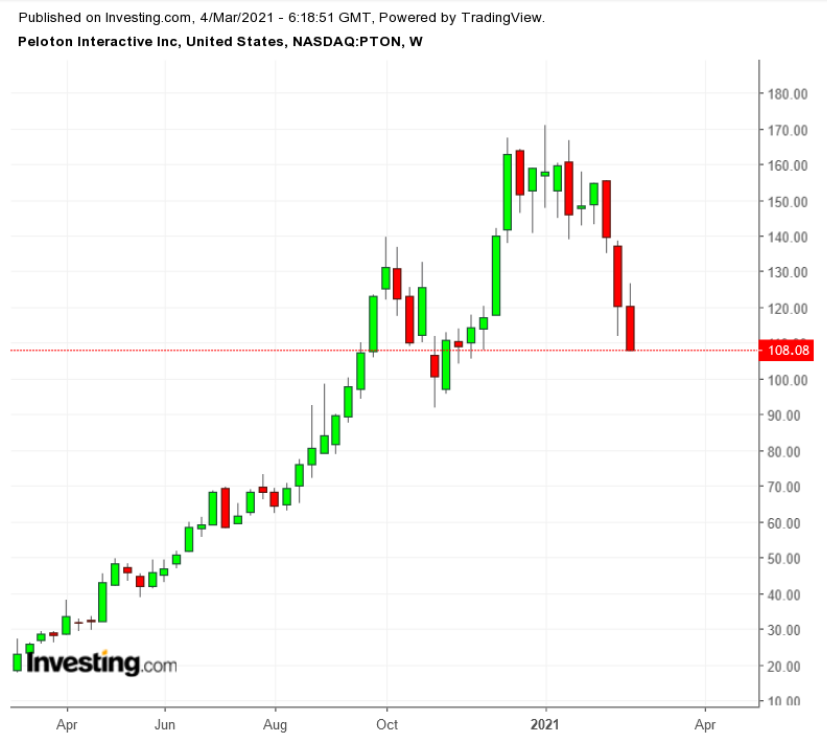It’s been a dismal start to the year for high-flying Peloton Interactive (NASDAQ:PTON) stock. Shares of the technology-based fitness company have fallen more than 25% so far in 2021, after surging about 500% last year.
This performance is much worse than that of the ARK Innovation ETF (NYSE:ARKK), a benchmark for companies providing disruptive technologies. That ETF is up about 5% for the year despite a broad-based market sell-off in growth-oriented stocks during recent weeks.
The slide in Peloton shares this year reflects concerns some investors have that the near-term peak in this New York-based company is over, following the COVID-19 lockdowns that led to major growth in the home-fitness market, with many gyms across the U.S. remaining closed.

Peloton’s current bearish spell, in our view, reflects both short- and long-term factors that are keeping investors on the sidelines. In the short-run, Peloton is struggling to keep up with the surging demand for its fitness machines.
For the quarter that ended in December, supply shortages for the company’s popular bike models hurt sales, with customers facing longer than “acceptable” wait times, according to the company.
On a conference call with analysts, Chief Executive Officer John Foley said the rollout of the company’s new treadmill will be delayed. In most of the U.S., the machine will launch in May, rather than the end of March. This is to meet demand in other regions, including the UK, where the new model went on sale in December.
Super Growth Cycle
Peloton made its largest acquisition in December when it bought fitness-equipment maker Precor for $420 million, to improve its U.S. manufacturing capabilities. It plans to spend more than $100 million in the first half for air and expedited ocean-based delivery to fulfill orders.
Despite the supply setbacks, Peloton’s latest numbers show that it continues to remain on a super-growth trajectory. In the quarter ending Dec. 31, it swung to profit. Revenue grew 128% from a year earlier, with quarterly sales surpassing $1 billion for the first time.
Connected fitness subscriptions—users who pay for classes on Peloton equipment—jumped 134%, while paid digital subscriptions—people who subscribe to classes on smartphones and other devices—rose a whopping 472%. Peloton now has more than 4.4 million users.
Over the long-run, however, one major question is whether Peloton is just a COVID story. Once the pandemic subsides, how will PTON keep its growth momentum going when people return to gyms?
One way to look at Peloton’s future growth potential: the company’s expensive products do create stickiness. Someone spending more than $2,000 on a spin cycle to use at home is less likely to quit and go back to a crowded gym.
Peloton chief financial officer Jill Woodworth told the Wall Street Journal in a recent interview:
“The fitness market is massive and has room for many players, both bricks and mortar and connected fitness online.”
“We believe we have a tremendous runway for growth. We think there’s a fairly large percentage of the population who are unlikely to, or who may not ever, return to a gym. So for us, we think it’s important to continue growing our connected-fitness memberships as quickly as we possibly can to keep our first-mover advantage.”
Analysts' consensus on a price target shows Peloton stock could jump 30% from its current level to $166.35 a share in the next 12 months if it’s able to overcome its supply constraints and continue to grow its subscription base.
Bottom Line
Peloton stock is likely to remain under pressure in the short run as investors look for signs that supply constraints are being resolved. That short-term negativity, in our view, is a buying opportunity for long-term investors, given the company’s strong share in the home-fitness market, its superior technology and its first-mover advantage, which will be hard to challenge.
